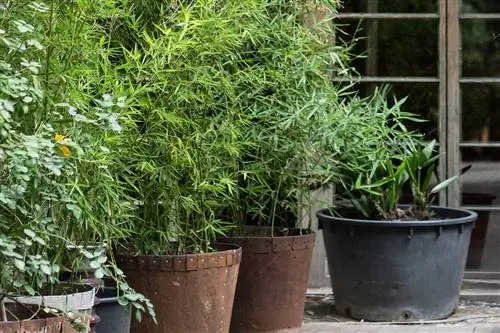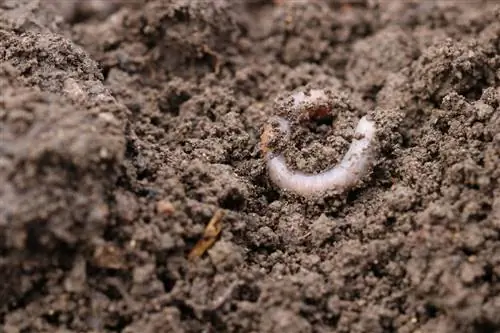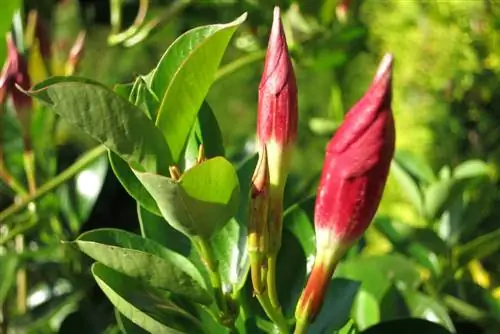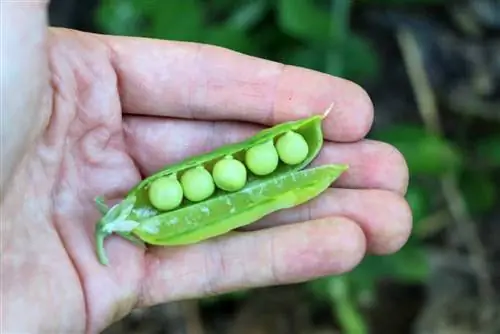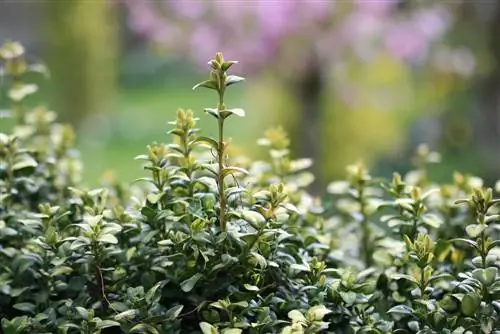- Author admin [email protected].
- Public 2023-12-17 03:39.
- Last modified 2025-01-24 12:45.
The bamboo plant, Latin Bambusoideae, belongs to the family of sweet grasses and is a plant similar to a tree. The plant has slender, woody stalks that are usually a few meters long and delicate leaf crowns. Depending on the variety, the height of a bamboo plant can reach up to 38 meters.
The plant grows particularly well in Algeria and southern France. In Germany it is mostly grown as a container plant. Other beautiful potted plants include olive tree, angel trumpet, oleander, passion flower, lemon tree and orange tree.
Propagation of bamboo
The bamboo can multiply easily because after just a few years it has formed enough rhizomes underground. The rhizomes can be cut off and easily replanted. Only rhizomes that have been tapped a year previously and have good roots should be used.
Care
The bamboo plant should be placed in a sunny and warm place where the wind is not too strong and humus soil should be used. It is also important to ensure that waterlogging is avoided. The bamboo plant is very thirsty and therefore needs to be watered regularly, including in winter, frost and summer. In summer, however, the plant should only be watered and the leaves sprayed in the early morning or late evening.
The bamboo plant is best purchased from nurseries, nurseries and horticultural centers. When purchasing, make sure that the seller provides you with care instructions and care instructions. Depending on the variety, the bamboo is available from just 10 euros.
Types of Bamboo
There are over a hundred bamboo genera and almost 1,300 bamboo species worldwide, including Sasa tsuboiana, Fargesia nitida, Fargesia nitida 'Nymphenburg', dwarf bamboo, Fargesa 'Mae', Sasa palmata, Phyllostachys humilis, Pleioblastus fortunei and Pseudosasa japonica are the best known species.
Bamboo as a pot plant
Bamboo is not only a great plant for the garden, some varieties are also well suited as a container plant. However, the choice of variety is important. Some of them are even suitable for keeping as houseplants. However, appropriately large containers are a prerequisite for lush greenery to form. If the habitat is too small, bamboo cannot develop. He needs space. The relationship between plant size and pot must be right. Therefore, it must be repotted regularly, always in a correspondingly larger container. Bamboo can grow to quite large proportions.
Requirements for keeping bamboo in pots
Cultivating bamboo in a pot is basically no problem if a few things are taken into account.
- adequate supply of water and nutrients
- Cover the bottom of the vessel with a thick layer of expanded clay
- cover this layer with fleece, only then does the plant substrate come in
Tip: There is special bamboo soil that is tailored to the needs of the plants. Special fertilizer for bamboo is cheap - usually a mixture of mineral and organic fertilizer. It must be repotted at least every two years, usually annually!
Location for container keeping
Bamboo looks good and goes well with modern architecture. Many people also want to use the decorative plants indoors. However, most types of bamboo feel much more comfortable outdoors. The tall phyllostachys in particular depend on the change of seasons. The humidity in rooms is also too low. Spider mites usually appear. Lice also settle there. All together weaken the bamboo.
Bamboo is very suitable for interior spaces
- Bambusa ventricosa
- Bambusa vulgaris ‘Striata’
- Bambusa multiplex ‘Alphonse Karr’
Bamboo in the winter garden
Bamboo that has spent the summer outdoors, which it absolutely should, loses some of its leaves after being set up. Many leaves may be lost. But new ones are usually formed quickly. Leaf fall is not uncommon with bamboo. The plants lose leaves around the clock.
Bamboo for the outdoors
- sunny to partially shaded location
- If possible, shelter from the wind so that the stalks grow straight up
Planting substrate for bamboo
You can't go wrong with pure bamboo soil, which is available in speci alty stores, but you can also do something else. In principle, bamboo thrives in any humus-rich soil. Fresh and nutritious soil is cheap, yet permeable and airy.
- Earth with clay components
- Granulated clay is ideal: it is inexpensive, is mixed underground, swells in the ground and provides good buffering
- Bentonite rock powder has a similar effect
- A neutral to slightly acidic soil is ideal
- If the soil is very alkaline, leaves and stalks may turn slightly yellow
Planting bamboo
The best time to plant bamboo is spring, i.e. March/April. August is also a good time when the shoots have finished forming. Since bamboo is usually offered as a container plant, you are not so strictly bound to these planting times. Only after the end of August should you stop planting.
- Drainage in the bottom of the pot is important!
- Wet feet must be avoided!
- Vessels must be sufficiently large!
Terracotta pots often crack in winter. The pressure of the rhizomes on the inner walls can also increase this. Terracotta-colored plastic containers are favorable in several respects. They are inexpensive, offer a lot of space and don't break if the wind knocks the bamboo over, which happens quite often.
- Pots must not narrow towards the top, otherwise the roots will get stuck.
- Drain holes are important.
- Plant plants quickly after purchase.
- Use a much larger container when repotting.
- When repotting, cut off about 3 cm of root plate from the bottom of the plant.
- Then dip the bale in water.
- Try to loosen the roots a little with your fingers.
- Be sure to use new substrate.
- Pay attention to drainage.
Watering and fertilizing
Unfortunately, bamboo is not suitable for hydroponics. The plants in the pot must be supplied with plenty of water. But waterlogging is fundamentally wrong. Lack of oxygen causes roots and rhizomes to rot. Bamboo needs water and nutrients, especially during new shoots.
- In summer you usually have to water every day.
- It is ideal to water in the morning or evening.
When there is a lack of water, bamboo triggers a protective mechanism: the leaves curl together and reduce their leaf surface and thus evaporation.
- You have to water even in winter! Evaporation continues.
- Bamboo has a high fertilizer requirement.
- Nitrogen-based fertilizer is ideal - it is best to administer this directly when planting.
- Otherwise, fertilize once in spring and once in August.
- Slow-flowing compound fertilizer is recommended.
- Horn shavings are good, they have a lot of protein and granulated cattle manure - alternatively lawn fertilizer works.
- When using Blaukorn, pay attention to a low dose. Too much s alt will burn the leaves.
- A lack of nitrogen can cause the leaves to turn yellow.
Cutting Bamboo
When cutting, it depends on what shape you want to achieve. Most of the time, only thinning is done and diseased or dead stalks are removed. What is important is what type of bamboo it is. When purchasing, you should ask how and when it is cut. The varieties differ and you cannot generalize. Some are cut heavily, others not at all.
Overwintering bamboo
Bamboo in a pot usually needs some winter protection. When it comes to winter hardiness, the duration of the cold and the humidity are crucial. Dry easterly winds and the alternation of low night temperatures and strong sun during the day are dangerous.
- Container plants with limited soil volume are more at risk of frost
- roots and rhizomes can be damaged in free-standing containers and prolonged cold
- Protect planters with bubble wrap, coconut mats or Styrofoam!
- Very protected location: sinking the pot into the ground is ideal - first water it thoroughly, then dig it in, then pile up a 30 cm thick layer of dry leaves on bales, don't forget to water every now and then!
- you can also wrap the bamboo plant in a winter fleece, which protects it from drying out due to evaporation
Conclusion of the editors
Bamboo is a great plant. Some varieties are also suitable for keeping in containers. When purchasing, pay attention to sufficient winter hardiness. It is important to regularly place the plants in larger containers so that they can develop well. If you want to stop growth, repot rarely! Otherwise, there is not much to consider when it comes to care. Whether and how you cut depends on the variety and how you want the plant to look.

